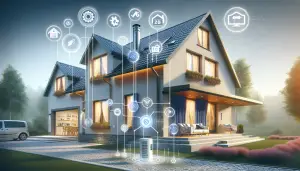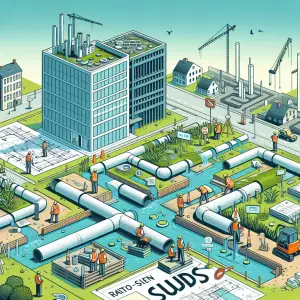Enhancing Energy Efficiency and Indoor Comfort: Best Practices for Maintaining Airtightness in Buildings
Airtightness in buildings isn’t just a fancy term tossed around by architects and builders; it’s a fundamental component for ensuring energy efficiency, thermal comfort, and superior indoor air quality. The concept revolves around preventing unwarranted air leaks through the building envelope, which includes walls, floors, ceilings, windows, and doors. Proper management of airtightness can lead to significant reductions in heating and cooling costs while enhancing indoor environments for occupants. Here’s a comprehensive guide to maintaining airtightness over time, packed with best practices that draw on expert insights, including those from Ratio Seven.
Sealing the Building Envelope
The unmistakable first step in promoting airtightness is meticulously sealing the building envelope. This involves using flexible caulks or sealants designed to close gaps around window and door frames, baseboards, and any areas where pipes or wires make their way through walls. The choice of sealant is crucial—it needs to last whilst remaining flexible enough to accommodate the natural movement of the building.
- Materials and Techniques: Opt for durable sealants like silicone or urethane-based options, known for their flexibility. These materials should cover all potential leakage points effectively.
- Target Areas: Pay particular attention to transition areas between different materials and construction phases, as these can become susceptible to leaks over time.
Improving Window and Door Seals
Windows and doors are frequent culprits for air leakage. Effective draught-proofing can significantly enhance overall building airtightness.
- Draught-proofing Options: Use draught-proofing strips such as brush seals or neoprene strips for sliding or hinged windows. These materials are effective in providing a snug fit that keeps drafts at bay.
- Invest in Quality: Consider upgrading to airtight windows and doors that meet rigorous standards like the Australian Standard AS2047. Such upgrades offer long-term benefits in maintaining energy efficiency.
Ducting and Venting
Proper sealing of ducts and vents is critical to maintaining airtightness, as these pathways frequently penetrate numerous areas of the building envelope.
- Sealing Techniques: Use adhesive sealing strips or spray foam to tightly seal HVAC ducts, especially at walls, ceilings, and floor penetrations.
- Ventilation Strategies: Kitchen and bathroom exhaust fans should vent directly outside, complete with draught stoppers to prevent backdrafts when not in use.
Insulating Ceiling and Wall Penetrations
Airtightness can also be compromised by ceiling and wall penetrations, such as those for downlights or skylights.
- Insulation Choice: Use vapour-permeable insulation for these penetrations to diminish air leakage risk.
- Sealing Gaps: Similarly, seal any gaps around electrical outlets and switches using gaskets or foam inserts to block drafts efficiently.
Upgrading Insulation and Membranes
During renovations or retrofits, it’s crucial to consider the state of existing insulation and membranes.
- Vapour-Permeable Membranes: These additions to walls and ceilings help manage moisture, maintaining airflow and reducing condensation and mould risks.
- Insulation Improvements: Improved insulation not only aids in airtightness but also bolsters thermal performance, enhancing indoor comfort.
Using Air and Vapour Control Layers (AVCLs)
AVCLs play an essential role in maintaining an airtight environment by preventing moisture-laden air from infiltrating the building envelope.
- Specialised Membranes: Consider using products like DuPont™ AirGuard® membranes on the internal side of the building envelope.
- Ensuring Continuity: Seal all joints and breaches meticulously using appropriate tapes such as Tyvek® Butyl Tape to maintain uninterrupted coverage.
Maintaining Continuity at Junctions
The junctions between adjacent walls, floors, and ceilings are potential weak points in airtightness, so proper attention is required.
- Lapping and Sealing: Lap the AVCL by 100mm at junctions and seal with suitable tape.
- Careful Consideration: This ensures airtightness even at intermediate floor levels and around fixings and services likely to breach the airtight line.
Incorporating Mechanical Ventilation Systems
In highly airtight designs, mechanical ventilation systems are indispensable.
- MVHR Systems: Mechanical Ventilation Heat Recovery systems ensure the building has a continual supply of fresh air, filters incoming air, and regulates temperature. This dual function maintains indoor air quality and optimises energy efficiency.
Regular Maintenance and Inspections
A commitment to airtightness requires regular maintenance.
- Inspection Routine: Regularly check the building envelope and ventilation systems to verify that seals remain intact and identify any signs of wear or damage.
Additional Considerations from Ratio Seven
- Balancing Airtightness and Ventilation: A delicate balance exists between achieving airtightness and ensuring effective ventilation. Overlooked ventilation can result in poor air quality indoors due to accumulated pollutants like formaldehyde and VOCs.
- Professional Consultancy: Ratio Seven offers expert consultations to provide detailed assessments and tailored recommendations. Their expertise is crucial for designing and implementing ventilation strategies that optimise both energy efficiency and indoor air quality.

FAQs: Understanding Airtightness in Buildings
Why is airtightness important in energy efficiency?
Airtightness is critical in reducing energy waste by preventing unwanted air infiltration. This minimises the burden on heating and cooling systems, ultimately lowering energy consumption and costs.
How does airtightness affect indoor air quality?
Airtightness and proper ventilation safeguards indoor air quality by ensuring controlled ventilation. Without adequate ventilation, airtight buildings can trap indoor pollutants, compromising health and comfort.
What role does insulation play in airtightness?
Insulation enhances airtightness by minimising air leakage and thermal bridging. Proper insulation works alongside airtightness measures to optimise thermal performance and energy efficiency.
By implementing these best practices and leveraging the expertise of professionals like those at Ratio Seven, homeowners and builders can ensure long-lasting airtightness in buildings. Achieving and maintaining a well-sealed building envelope offers numerous benefits, from reduced energy bills and improved thermal comfort to a healthier indoor climate. As we’ve seen, a comprehensive approach to airtightness is the foundation of sustainable, efficient, and comfortable living spaces.




